Acer Aspire V3-571G-9435: The Value Proposition
by Jarred Walton on July 4, 2012 4:25 AM ESTAcer V3-571G General Performance
We start as usual with our general performance application benchmarks. We still don’t have quite as many laptops available in our updated Mobile Benchmark Suite as we’d like, and there’s not much point in comparing a full-size notebook with several different models of Ultrabook. We’ve tried to stick with the more meaningful comparisons where possible, but we also wanted to flesh out the charts with additional data points. The result is the following selection of laptops, with their basic specs listed in the table, and as always, should you want to make additional comparisons, head over to Mobile Bench.
| Laptop Configuration Overview | ||||
| Laptop | CPU | Graphics | Storage | Battery |
| Acer Aspire V3-571G | Intel i7-3610QM | GT640M/HD4000 | HDD | 48Wh |
| Acer TimelineU M3 | Intel i7-2637M | GT640M/HD3000 | SSD | 55Wh |
| AMD Trinity Prototype | AMD A10-4600M | HD7660G | SSD | 56Wh |
| ASUS N56VM (Prerelease) | Intel i7-3720QM | GT630M/HD4000 | HDD | 56Wh |
| ASUS Zenbook Prime UX21A | Intel i7-3517U | HD4000 | SSD | 35Wh |
| ASUS G74SX-A2 | Intel i7-2630QM | GTX560M/HD3000 | SSD | 90Wh |
| Clevo W110ER | Intel i7-3720QM | GT650M/HD4000 | Hybrid | 62Wh |
| Razer Blade | Intel i7-2640M | GT555M/HD3000 | SSD | 60Wh |
| Sony VAIO SE | Intel i7-2640M | HD6630M/HD3000 | HDD | 49Wh |
| Toshiba P755D | AMD A8-3520M | HD6620G | HDD | 47Wh |
As we’re starting with PCMark results, we again want to note how much of an impact the presence of an SSD has on the results. It makes most of the comparisons between the HDD and SSD equipped laptops meaningless, but it does serve to drive home the point that for some workloads an SSD will make a huge difference. I switched over to a 240GB SSD for my laptop and Ultrabook use, and whenever I have to use and test a laptop that only has HDD storage (like the Acer V3), the difference is painfully obvious.
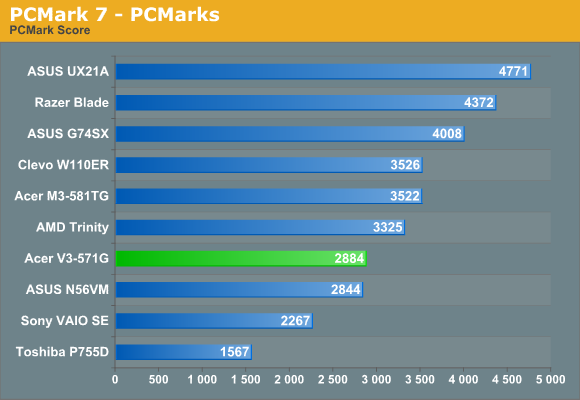
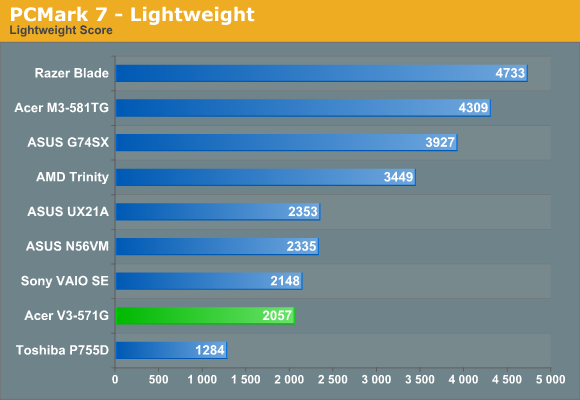
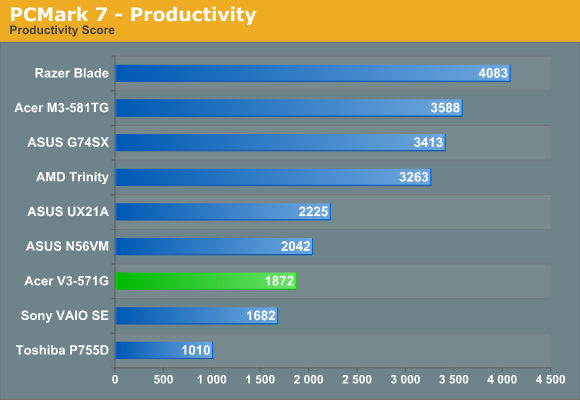
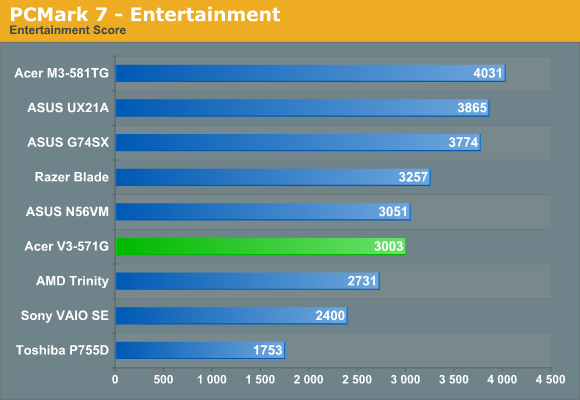
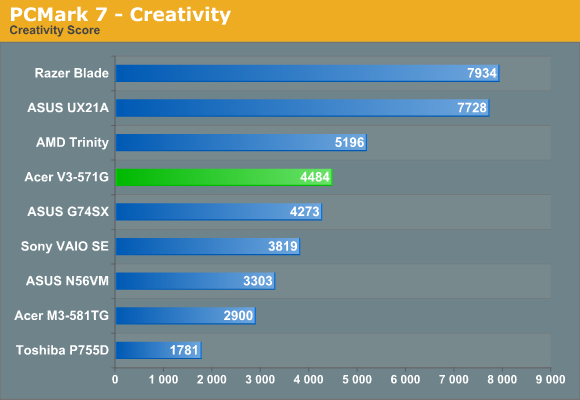
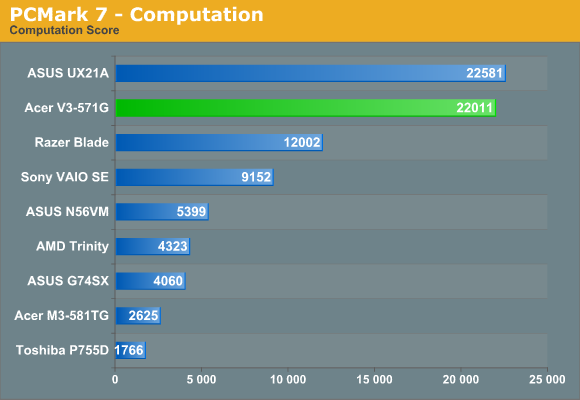
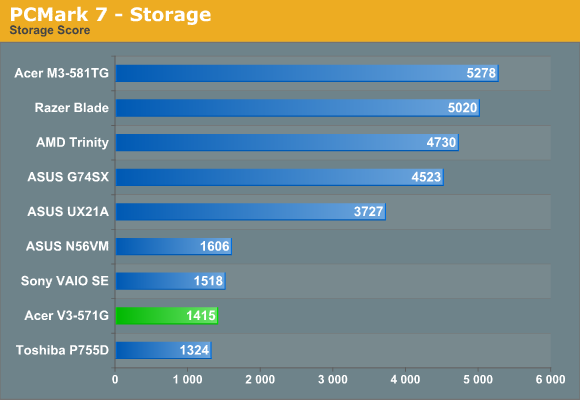
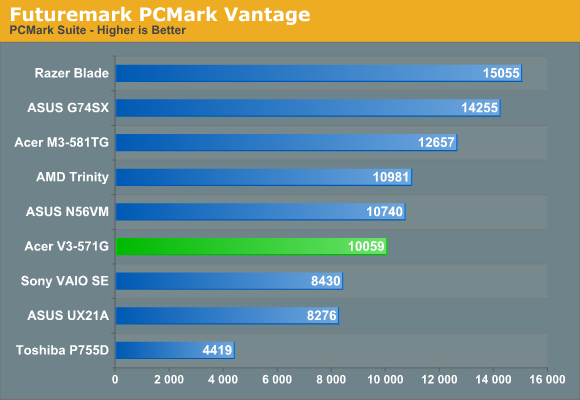
The placement of the Acer V3 in the above charts isn’t very inspiring, but remember what we said about SSDs. Most of the higher scoring laptops feature SSDs and/or slightly faster CPUs. For general use, any of the laptops will be “fast enough”, and as long as you don’t mind waiting during intense periods of disk activity (e.g. initial boot up of the OS and various applications) even the HDD equipped laptops will work well. Still, one look at what an SSD does for the ASUS N56VM might make you consider splurging on better storage system. Acer adds insult to injury here by going with a 5400RPM hard drive, and the only slower Storage score in the charts comes from the Toshiba P755D—which also uses a 5400RPM Toshiba hard drive, not surprisingly.
If we look at the one PCMark 7 test that doesn’t hit storage at all, the Computation suite, we run into a different problem. Here, all of the laptops that support Intel’s Quick Sync technology get a massive performance boost, and the Ivy Bridge processors are basically twice as fast with Quick Sync as Sandy Bridge parts. It makes for yet another lopsided graph, which makes the overall usefulness of the PCMark scores debatable. As long as we understand what the charts represent, however, we can at least use them to gauge relative performance. The basic summary is that, for general use, a moderate CPU (e.g. Trinity, Llano, or Sandy Bridge) with an SSD will offer a better experience than just about any current HDD-based laptop; similarly, if you want to do hardware accelerated video encoding, there’s no beating Quick Sync.

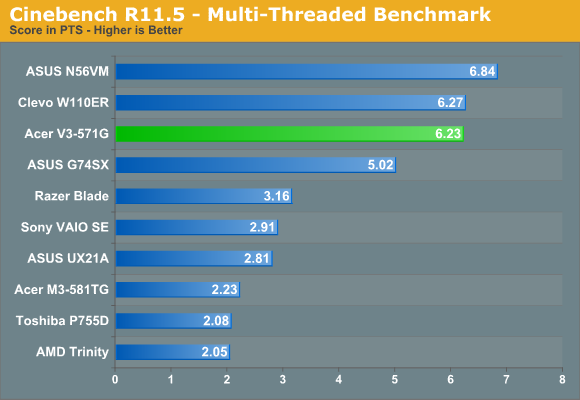
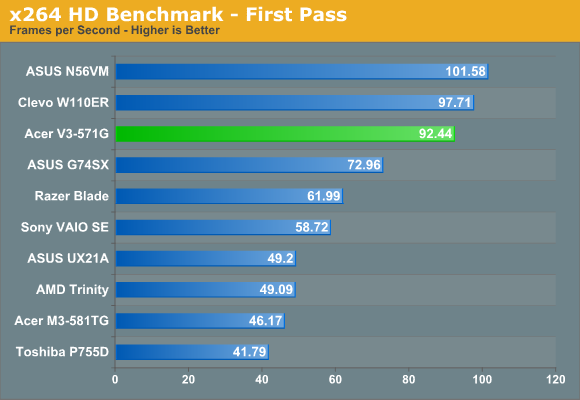
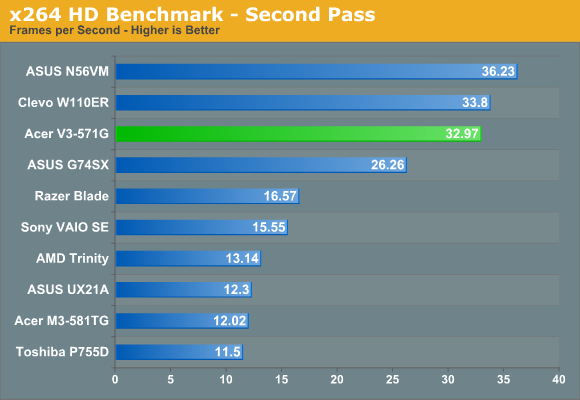
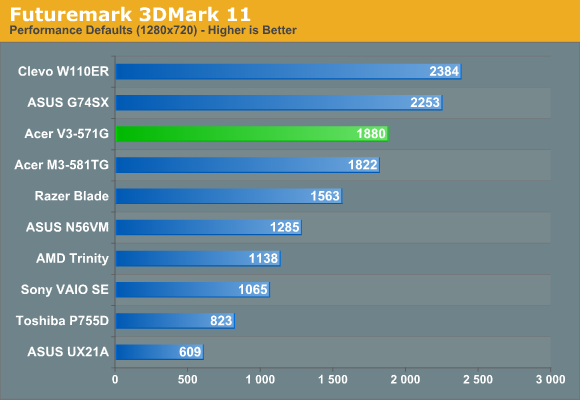
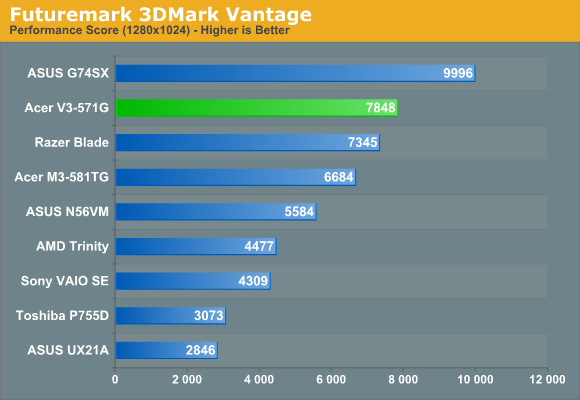
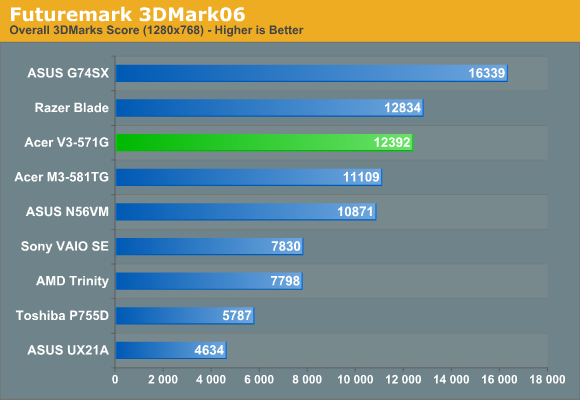
When we shift over to our more CPU- and GPU-centric tests, the performance results start to look more sensible. As one of two quad-core Ivy Bridge laptops, the Acer V3-571G takes second place in all four of our CPU-based tests, losing out by a small margin to the higher clocked i7-3720QM in the ASUS N56VM. The 3DMark scores tell a similar story, although this time it’s the GTX 560M in the ASUS G74SX that takes first place, with the GT 640M generally falling into second place and trading blows with the Razer Blade and Acer M3-581TG Ultrabook. The latter has the same GPU but a slower ULV Sandy Bridge processor, and we should hopefully have the updated M5 Ivy Bridge model in for testing in the near future.










88 Comments
View All Comments
rwei - Thursday, July 5, 2012 - link
I'm in favor of the "repeatedly beat the manufacturers with a stick for using crappy screens" approach. Better to complain loudly than to suffer in silence.Though, I've noticed that these days most of the Anandtech reviews spend less time lamenting the screens - more like a line or two saying "meh, ANOTHER crappy screen", rather than the old reviews where it was not uncommon to see a 500+ word diatribe on how bad screens were the root of all sin.
When I switch from my Envy 4t (14", 1366x768, sigh) to my Envy 17 (1080p upgraded LCD), it always startles me. That the 17's screen is so much bigger and yet STILL has a denser screen never fails to impress on me how bad the 4t's screen is. And that's not even discussing the colors and contrast...
Such a shame, because the 4t and so many other laptops would be fantastic machines they didn't have such awful screens.
kmmatney - Thursday, July 5, 2012 - link
90% of people I know would be fine with a Core i3 laptop, priced around $400. I just bought an HP laptop (for someone else) at Microcenter at that price, and it's not bad for the price.I feel this Acer laptop is in a funny place - it has the screen of a $400 laptop, and the processor of a more expensive one. It is too expensive for me to want to buy for personal use, and yet too cheap for a business - my laptop budget for my job is around $1200.
jmunjr - Thursday, July 5, 2012 - link
Keep reviewing as many laptops as you can, but make it clear to readers how poor the screen is, make it very clear.cknobman - Wednesday, July 4, 2012 - link
I may not be in the majority (of the masses at least) but I refuse to buy a laptop with a screen resolution below 1600x900.Heck last laptop I purchased was in 2010 and even then I refused to go lower than 1600x900.
CSMR - Wednesday, July 4, 2012 - link
Could be good for someone wanting a laptop to connect to different external displays (e.g. work, home office setups), who would just use the internal screen on occasion.benoitlevesque - Wednesday, July 4, 2012 - link
720P IS GREAT for cheap gaming laptop. At this resolution its fairly easy to get decent FPS even with high details. If the resolution was 1080p the GPU would struggle way too much and you would be stuck with mediocre FPS even at low details. If the only thing you want is web browsing and office work, this is not a good laptop for you IMO.whatthehey - Wednesday, July 4, 2012 - link
Try telling this to older people that can't read text on 720p displays. Or try explaining to someone why they need to spend an extra $200+ for a laptop with a better display when "It looks fine to me. What did you say was wrong with it?"You techno snobs (aka "enthusiasts") are delusional when it comes to what makes for a good laptop or desktop in most people's eyes. They want it to be fast enough, but more importantly they want it to be affordable.
If you want a high quality laptop with an excellent display, go buy a MacBook Pro Retina for $2100+. Meanwhile, the average consumer will buy this $800 laptop that apparently doesn't deserve a review, and in a couple years they'll be another $800 laptop to replace it, and they'll be perfectly content not knowing how awful their system is.
You probably also tell everyone you know that they shouldn't but Dell or HP desktops and should just build their own. Then they can get a GTX 680/HD 7970 graphics card instead of the horrible GT 630/HD 7570 most prebuilt systems ship with (or God forbid, the integrated HD 2500/4000 graphics). Except, for the hundreds of millions of adults that never play games, having that extra graphics horsepower means diddly.
CSMR - Thursday, July 5, 2012 - link
Ridiculous, the better the quality of screen (higher resolution, better contrast, better viewing angles etc.) the easier it is to read text. You can measure this by speed of reading, and fatigue. Ordinary consumers buy poor quality displays because mainly they are not informed. I am not saying everyone should buy a high end display, but producing a reasonable quality display in 2012 is not expensive.JarredWalton - Friday, July 6, 2012 - link
I'd disagree with this, at least for older users. I have encountered so many >40 people that can't handle even using native resolution on a 24+ 1080p display. I helped set up a dental office for example where all of the secretaries and receptionists (40-60 years old) complained like crazy until I dropped the display settings down to 1366x768 -- yup, even on a 24" display, and even with them wearing their glasses.I'm not saying there's no point in good displays, but I would definitely agree that there's a large number of users that apparently can't tell a good LCD if it walks up an bites them in the rear. I'd wager the number of computer users that actually know (and recognize) a display with good contrast without having it explained over a five minute period (with a demonstration) is a lot smaller than most of our readers think.
Bottom line is that we'll still continue to call out bad displays in our reviews, but clearly there are a ton of people buying laptops with bad displays and they apparently don't notice and/or don't care. I call it the "Best Buy Phenomenon".
aliasfox - Monday, July 9, 2012 - link
I can never forget when an ex once pointed to the screen on her budget, bottom-of-barrel HP laptop and told me 'this is how pictures are supposed to look' and prefered the washed out low-contrast light bleeding screen to the IPS on my iPad.It's gotten to the point where some people simply can't even tell when they're experiencing quality:
- Prefering low light P&S pictures to an SLR
- MP3s from a blackberry speaker to a CD from my (very nice) sound system, just to name a few more examples
I'm all for trying to show people the difference, I just get the feeling I'll be branded elitist if I try.